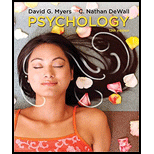
Concept introduction: The sensory organs are stimulated by different stimuli. These stimuli are then converted into sensations by sense organs. These sensations are transmitted to the concerned parts of the brain. At last, the brain will interpret these sensations. The sensation is the ability of the body to detect both internal and external stimulation. The process of interpreting and recognizing sensory stimuli is called perception.
Answer to Problem 1MM
Correct answer: Sensation is to bottom-up processing as perception is to top-down processing.
Therefore, option b. is correct.
Explanation of Solution
Reasons for the correct statement:
The two main processes involved in the sensation and perception are bottom-up processing and top-down processing. The bottom-up processing refers to the processing of the sensory information and top-down processing refers to the perception from the sensory input by drawing the expectations and experience. It is driven by the cognition.
Option b. is given as “bottom-up processing; top-down processing”.
Bottom-up processing starts at the sensory receptors for processing and top-down processing make the perception from the sensory input by drawing the expectations and experience.
Therefore, option b. is correct.
Reasons for the incorrect statements:
Option a. is given as “absolute threshold; difference threshold”.
A lowest level of strength that is essential for the detection is called absolute threshold and difference threshold is the minimum difference between the stimulation that is necessary for a person to detect 50 percent of the time.
Therefore, option a. is incorrect.
Option c. is given as “interpretation; detection”.
The process by which we represent and understand stimuli is called interpretation and detection is a weak signal or stimulus which depends upon the psychological state and strength.
Therefore, option c. is incorrect.
Option d. is given as “grouping; priming”.
The tendency of the humans to organize stimuli into some coherent groups is termed as grouping and priming is the implicit memory effect in which the exposure to a stimulus influences the response to a later stimulus.
Therefore, option d. is incorrect.
Hence, options a., c., and d. are incorrect.
Want to see more full solutions like this?
Chapter 17 Solutions
Psychology in Modules
- Summarize key aspects on the buddhism tradition that has impacted your understanding of religious diversity?arrow_forwardwhat important foundational factors and sacred texts and traditions for the buddhism tradition? use 2 scholarly articles properly citedarrow_forwardwhere and how did the buddhist tradition emerge?arrow_forward
- for a drug treatment program what are the prominent theories/models that underlie the service provided. Moral Model, Medical - Disease Model Learning Theory, Psychoanalytic Theory. Ecological Perspective, Family Theory, Bio Psycho Social Theoryarrow_forwardwhat skills or information do you need to improve the quality of your work with Alcohol or drug abuse clients?arrow_forwarddescribe an imaginary/factious treatment agency/program addressing clientele, level of care, curriculum, assessment procedures, treatment plans, case management and counseling issues, staff issues, etcarrow_forward
- Construct an example of a peer evaluation. Instructions: Clarity and coherence of writing Depth of musical analysis Accuracy and relevance of observations Organization and structure of the report Grammar, spelling, and punctuation Originality of workarrow_forwardDraft an example of a peer evaluation. Instructions: Clarity and coherence of writing Depth of musical analysis Accuracy and relevance of observations Organization and structure of the report Grammar, spelling, and punctuation Originality of workarrow_forwardMatch musicians with a style of jazz. Prompts Answers Antonio Carlos Jobim Bossa Nova Tito Puente Latin Jazz Maceo Parker Third Stream Gil Evans Funkarrow_forward
- Write an example of a personal reflection of your course. - What you liked about the course. - What you didn’t like about the course. - Suggestions for improvement. The Reflection Paper should be 1 or 2 pages in length.arrow_forwardHave you experienced a state of flow? If so, please describe what you experienced, and what factors you think contributed to this occurring. If not, discuss what you think might assist you in experiencing flow. Do you believe it is necessary to be in a state of flow to fully engage in creative work; or is it helpful but not strictly necessary? Support your position with your own observationsarrow_forwardThis unit is designed to introduce students to the principles of community psychology and examine local issues through a lens of social determinants of health. Students will explore varieties of community issues such as homelessness, substance abuse, visible and invisible disabilities, and the public health crisis of racism. By analyzing the ways in which SDH intersects with both physical and mental health, both in their own communities and in differing communities, students will understand how social inequities can significantly impact the overall health of a population. Short Description This activity explores how inequality has both physical and psychological impacts on the individual and the community's health. Students will use a step-by-step analysis of SDH around the world. Instructions Using the unit readings, review the Social Determinants of Health: Public Health Agency of Canada. (2020, October 7). Social determinants of health and health and health inequalities. Government…arrow_forward
 Ciccarelli: Psychology_5 (5th Edition)PsychologyISBN:9780134477961Author:Saundra K. Ciccarelli, J. Noland WhitePublisher:PEARSON
Ciccarelli: Psychology_5 (5th Edition)PsychologyISBN:9780134477961Author:Saundra K. Ciccarelli, J. Noland WhitePublisher:PEARSON Cognitive PsychologyPsychologyISBN:9781337408271Author:Goldstein, E. Bruce.Publisher:Cengage Learning,
Cognitive PsychologyPsychologyISBN:9781337408271Author:Goldstein, E. Bruce.Publisher:Cengage Learning, Introduction to Psychology: Gateways to Mind and ...PsychologyISBN:9781337565691Author:Dennis Coon, John O. Mitterer, Tanya S. MartiniPublisher:Cengage Learning
Introduction to Psychology: Gateways to Mind and ...PsychologyISBN:9781337565691Author:Dennis Coon, John O. Mitterer, Tanya S. MartiniPublisher:Cengage Learning Psychology in Your Life (Second Edition)PsychologyISBN:9780393265156Author:Sarah Grison, Michael GazzanigaPublisher:W. W. Norton & Company
Psychology in Your Life (Second Edition)PsychologyISBN:9780393265156Author:Sarah Grison, Michael GazzanigaPublisher:W. W. Norton & Company Cognitive Psychology: Connecting Mind, Research a...PsychologyISBN:9781285763880Author:E. Bruce GoldsteinPublisher:Cengage Learning
Cognitive Psychology: Connecting Mind, Research a...PsychologyISBN:9781285763880Author:E. Bruce GoldsteinPublisher:Cengage Learning Theories of Personality (MindTap Course List)PsychologyISBN:9781305652958Author:Duane P. Schultz, Sydney Ellen SchultzPublisher:Cengage Learning
Theories of Personality (MindTap Course List)PsychologyISBN:9781305652958Author:Duane P. Schultz, Sydney Ellen SchultzPublisher:Cengage Learning





